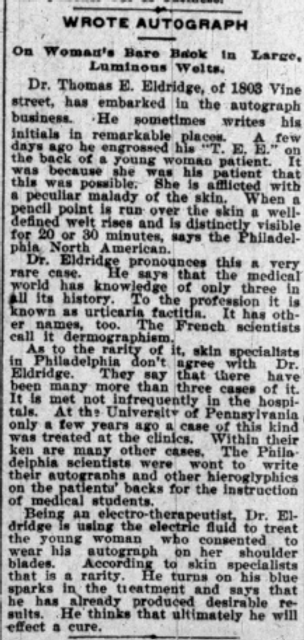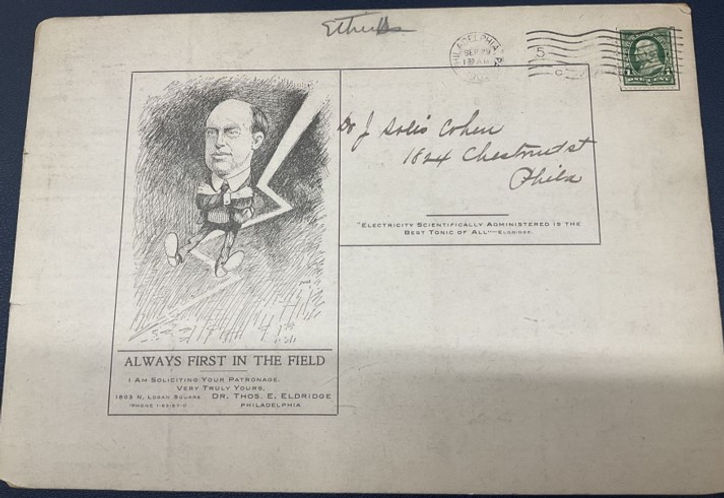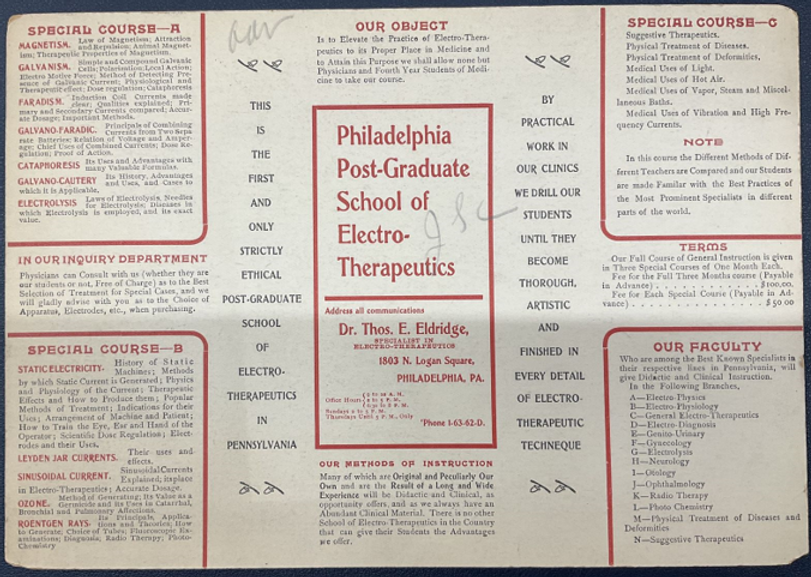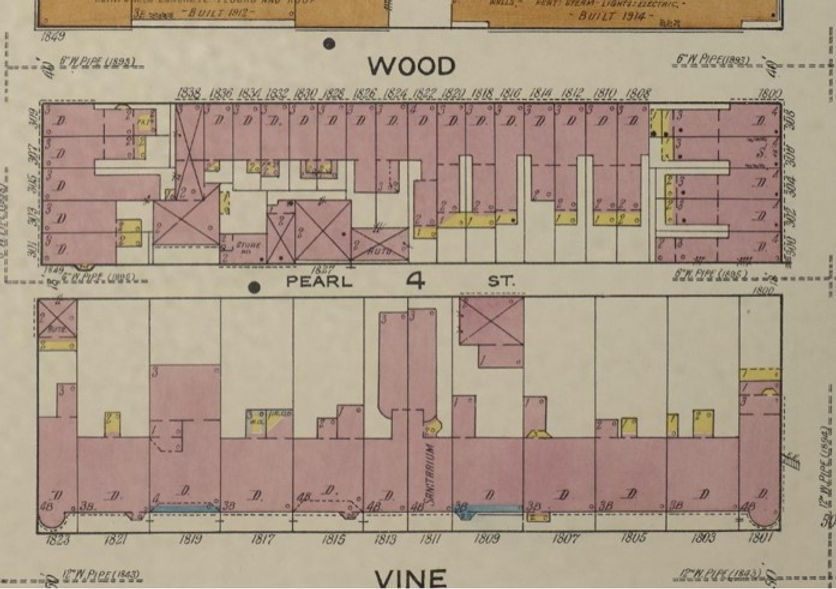Thomas Eldridge and His Sanitarium

Portion of a Bromley map from 1901 showing a different Logan Square. Large houses faced the Square, especially along Vine Street. Eldridge first lived and worked at 1803 Vine Street, then at 1811 Vine Street.
There was a whole street, West Logan Square, that was removed when the Fairmount Parkway was built. The 1800 block of Vine Street was demolished in 1822 for the Family Court Building; the 1900 block of Vine Street for the Parkway Central Library; and the east side of 18th Street north of the Gynecean Hospital for the Vine Street widening project of the 1950s.
In the early 1900s there was a resident of our neighborhood who craved attention in the newspapers, and received it. He is little known now, but was a regular subject in the local and regional newspapers. Among these news accounts about him were the following:
-
An attempt to have his ex-wife blown up;
-
An attempt to resurrect a corpse that was several days dead;
-
An attempt to turn a black man white using radiation;
-
A conviction for practicing medicine without a license;
-
Several successful balloon flights setting local altitude and distance records, including at least one flight with a parachute jump;
-
Being the first passenger in a plane over Philadelphia, the plane piloted by the notorious Grover Cleveland Bergdoll, in the same Wright brothers’ plane now hanging in the Franklin Institute;
-
Having prominent Philadelphians join him on balloon flights, including guests with names like Strawbridge.
Here is his story.
First, some background on neighborhood medicine of the time.
Hahnemann Hospital was founded as a homeopathic hospital, practicing a non-science- based form of therapy that today is a fringe alternative treatment. Articles on this website have already discussed two other institutions that would now be considered fringe: the Radium Institute at 1725 Spring Garden Street and the Philadelphia College of Osteopathic Medicine (although PCOM today is a conventional allopathic hospital). There was another facility, at 1811 Vine Street from 1909 to 1922, that was founded by either a charming huckster or a true believer in electricity and radiation as a cure for almost all disorders. His name was Thomas E. Eldridge.
Eldridge was born in Devonshire, England, in 1867. He made his way to Detroit, Michigan in 1887. There he married Mary Jane Leathorne in 1890 and they had a son in 1893. While in Detroit he ran a shoe business but was sued twice for misrepresentation of his assets to creditors and failing to pay his suppliers. He claims to have graduated medical school in Michigan in 1896, although my search through the records of Detroit medical schools of the time did not reveal his name. The family moved to West Philadelphia between then and 1899, with a brief stop in Pittsburgh. In 1899 the couple separated and Thomas moved to 1803 Vine Street.
Medical education tangent:
In 1900 there were 160 MD degree-granting institutions in the United States and Canada. Most of these were proprietary schools run for extra income by physicians. The criteria for admission did not necessarily include any college courses, and most were two-year medical schools with variable exposure to actual patients. In 1910 the Flexner Report was commissioned by the American Medical Association to report on and squash these deficient institutions and set up standards for admission and graduation. Over half the medical schools that existed prior to Flexner either folded or were merged into university-affiliated medical schools. Eldridge, if he did indeed attend any school for medical training, may have attended a small town proprietary school.

An article from the Henderson County Graphic-Reporter, in Illinois, from 6 August, 1896.
The mob of "infuriated Italians" expedited Eldridge's eastward journey from Detroit to Philadelphia. One day after the chase the physicians were cleared of wrongdoing based on the coroner's finding that no operation was actually performed. The woman was determined to have died of a blood clot.
On May 11, 1901, Thomas E. Eldridge was living and working at 1803 Vine Street, where he had elegantly furnished offices with a sign in the window reading “Dr. Eldridge, Specialist in Electro-Therapeutics.” That night he was arrested and charged with conspiracy to have a hired man, Paul Schroeder, administer morphine to his ex-wife via hypodermic and take from her person papers related to his divorce proceedings. If that plan failed Schroeder was to use dynamite to blow up the back of her house at 3202 Summer Street in the Mantua section of West Philadelphia. Schroeder had contacted police authorities who then witnessed the criminal transactions between Eldridge and Schroeder. The police arrested Eldridge, after which he gave a partial confession. Eldridge failed to make the $1,500 bail and was sent to Moyamensing Prison pending trial. Mary Jane stated that she had the papers with her lawyer, and told police that Thomas had tried to smother her and had threatened to shoot her during their marriage. All of this was page one news in Philadelphia and around the country.
There was no further reporting of this case in the newspapers. I suspect Thomas and Mary Jane reconciled and averted a trial, as she was living with him at 1811 Vine Street in the 1920 census. She is also buried with him, along with their son and the son’s wife, in West Laurel Hill Cemetery. True love is apparently stronger than dynamite.
In any case, “Doctor” Eldridge is back to notoriety in January of 1902. No local papers covered his attempt to use his electro-therapeutics to raise a man from the dead, but it made the news in Wilkes-Barre and Paterson, New Jersey:

Article on the left from the January 10, 1902 edition of The Wilkes-Barre Times
and on the right from the January 11, 1902 edition of The Morning Call from Paterson, New Jersey. As Eldridge explains in The Morning Call article, his resurrection would have worked on the hanged convict except for the fact that his neck was broken.
The next newspaper account is less sensational but illustrates Eldridge's modus operandi.
About two to five percent of people will have a skin reaction when someone "draws" on their skin with a fingernail or object. The raised, red welt lasts for some thirty minutes and then disappears. There are no distressing symptoms to the patient. Eldridge tried to gain fame for a Philadelphia case of dermographism by drastically overstating its rarity and attempting to use electrotherapy to effect a "cure." All the hallmarks of quackery are there: sensationalizing the common, presenting a new but mechanistically impossible treatment plan, and seeking newspaper glory. In reality, the temporary skin reaction needed no treatment except to stop writing on the patient's skin.

Article from the Commercial, a paper in Bangor, Maine, from July 19, 1902.
Eldridge solicited referrals from other doctors in town, using the more prestigious-sounding address of 1803 N. Logan Square instead of 1803 Vine Street as his office. His motto was the double-absolutist phrase "Always First in the World," with him sketched astride a lighting bolt.

The addressee of this 1902 solicitation, Jacob Solis Cohen, was a member of a family that had been in Philadelphia since 1780. Ironically, Dr. Solis Cohen was appointed lecturer on electro-therapeutics at Jefferson Medical College in 1867, so he probably had little to learn from the upstart “Doctor” Eldridge. The reverse of the solicitation postcard is below. These are photos of the actual card taken at the library of the College of Physicians of Philadelphia. The postmark is dated September 29, 1902. Eldridge would move to 1639 North Broad Street in 1903 and be there for six years.

Reverse of postcard
Electrotherapeutics had advocates and critics. Our neighborhood's own Joseph Price MD was not a fan, as he details in a speech recorded in 1891 edition of the Transactions of the College of Physicians of Philadelphia here.
Some of his hometown papers were more skeptical of Eldridge in their coverage.

Part of a longer article in The Philadelphia Inquirer on July 26, 1904. “Doctor” Eldridge seemed to believe the adage that any publicity is good publicity. The summary here doesn’t even include the conspiracy to murder his ex-wife. One month prior to this article, Eldridge had been found guilty of practicing medicine without a diploma or a license or a registration, all of which were required by the State since 1893. In that trial he had been defended unsuccessfully by ex-mayor of Philadelphia Charles F. Warwick. Eldridge took the strategy of denying at trial that he had ever practiced as a physician, but confined himself to electrical treatments. It was quite obvious, however, that he had been using the title “Doctor.”

Creepy ad from the Inquirer of April 4, 1907.
Most of his patients were women, several of whom stayed in his townhouse as boarders during their "treatments." Eldridge frequently placed want ads for young women of refinement as aides for his patients, or here for assistant demonstrators. This ad seems overly specific in the physical requirements.
Eldridge purchased a four-story house at 1811 Vine Street in 1909 for $15,000 from D. B. Martin, the owner of an abattoir at 30th and Market in a building which still stands. Into 1811 Vine Street, Eldridge moved his business from 1639 North Broad Street, where he had billed himself as a “specialist in electro therapeutics” and also did manicures. According to the 1920 census, he lived at 1811 Vine with his wife and son, as well as permanent residents that he employed: a secretary, a nurse, a cook, a housekeeper, and a houseman. Unlike today’s Logan Circle, Logan Square in 1901 was a prestigious residential address with large townhomes surrounding it. Eldridge, who reportedly wore diamonds and furnished his office elegantly, wanted the prestige of a Logan Square address.

Portion of 1916 Sanborn map showing the sanitarium at 1811 Vine Street. To the north across Wood Street are Girls Catholic High School (later renamed Hallahan) and Cathedral Parochial School.
Eldridge embedded himself into the social scene in Philadelphia as best he could and was an outstanding self-promoter. In 1907 he discovered a new hobby that kept his name in the papers: ballooning. He took his first ride in a hot air balloon in 1907, leaving from the UGI plant in Point Breeze. He took hundreds of flights, and even parachuted out of a few as a thrill. He set an altitude record of 17,050 feet in 1910 with buddy Welsh Strawbridge. The duo ballooned from Philadelphia to New Hampshire in 1910, setting a local distance record. Eldridge flew as a passenger with Grover Cleveland Bergdoll in the Wright Brothers’ plane now in the Franklin Institute. That flight occurred in 1912, just after Bergdoll purchased the Model B Wright brothers plane for $5,000. The flight was the first over Philadelphia with a passenger. These exploits, and his presidency of the Philadelphia Aeronautical Recreation Society which he founded, made him a popular lecturer at the Lulu Temple, the Lions Club, the City Business Club, and women’s social clubs. He had a lecture hall at 1811 Vine Street and invited other (real) physicians to visit and learn.
Eldridge was an early adopter and marketer of new technologies. Wilhelm Röntgen discovered X-rays in 1895. Radium was isolated by Marie Curie in 1898. Both radiation sources created a mania for both frivolous and supposedly therapeutic uses. Doctor Henry Pancoast, head of radiology at the University of Pennsylvania Hospital in 1904, was aware of Eldridge's attempt to electrically resuscitate a corpse, and called Eldridge a consummate quack. Pancoast had noted lightening of the skin of black patients when therapeutic x-ray treatments were applied to cancers and skin diseases. Eldridge was apparently aware of these side effects. Eldridge took these side effects in a new direction: intentional whitening of the skin of six black men (by his count) at the request of the patients.
It was just seven years earlier, in the 1896 Plessy v. Ferguson case, that the Supreme Court made "separate but equal" the law of the land and skin color became a legal issue. Plessy himself had one-eighth black ancestry and could, if he chose to, pass as white. Some states had laws specifying that one-eighth black ancestry met the legal definition of being black, or some that any black ancestry met the legal definition of being black (Pennsylvania law did not specify). The public was fascinated by the potential intervention of technology in a race issue.
Eldridge’s attempts to turn a black man’s skin to white made national news. He followed that up by removing the spots on a leopard, apparently to answer the biblical question in Jeremiah13:23 that asks "Can an Ethiopian change his skin or a leopard its spots?" This guy was his own marketing maven! All these feats were verified only by his say-so. Before he could duplicate the experiments, his equipment seemed to have burned in one of the fires mentioned above. It must be said that Eldridge at least was a pioneer in quackery, since he used both X-rays and radium to effect skin color changes. As discussed in our article on the Radium Institute at 1725 Spring Garden Street, radium was not being marketed to health providers until 1914.
Eldridge's skin whitening cases were never confirmed. It may be that he was dealing with people who had vitiligo (a chronic autoimmune disorder that depigments the skin) or depigmentation caused by scarring from the x-ray or radium burns. It may also simply have been a hoax perpetrated by Eldridge for attention.

An article from the New York American of January 10, 1904 from the Smithsonian Archives. Subtle and not-so-subtle racism pervades the story. The New York American was part of the William Randolph Hearst publishing empire, and sensationalism was never a pejorative in his world.
Note the caption on the lower photo about the X-rays: “the hole in the rubber glove leaves only the growth exposed.” There was much to yet learn about X-rays!

From the 1913 book The Distinguished Men of Philadelphia and of Pennsylvania
The short biographies give “salient facts furnished by the subjects themselves.” Most of the facts are hard to verify for Eldridge, except that he is the self-proclaimed “dean” of the Philadelphia Post-Graduate School of Electro-therapy and “president” of the Eldridge Electro-therapeutic Sanitarium. I suspect faculty and board meetings could be held simultaneously in a phone booth.

1917 Letter to the editor of The Evening Public Ledger from a humble-bragging “MD.”

Ad from The Evening Public Ledger of September 20, 1920.
Caveat emptor when a healer claims to be adept with the therapeutic use of so many unrelated tools: electricity, nuclear physics, the electromagnetic spectrum from X-ray to infrared, ozone, and mechanical vibration. The same warning applies to those who claim to treat diverse diseases like cancer, bacterial disease, neurologic disease, and psychiatric disorders.
In 1922 the block of houses along Vine Street was condemned and demolished for construction of the new Family Court Building. Eldridge purchased back-to-back houses at 1507 Girard Avenue and 1508 Flora Street and moved there. 1507 Girard still exists; 1508 Flora is an empty lot owned by the Philadelphia Land Bank.
Eldridge posted separate for-sale notices for the following: his electrical machines, his parrot that spoke thirty sentences, an aquarium, and his thoroughbred prize-winning black French poodle, all cheap because he “must move.” It is not clear why he couldn’t take his menagerie with him on his move just one mile north.

Ad from The Philadelphia Inquirer of October 4, 1929. The Volstead Act of 1919 that initiated Prohibition had an exception: doctors could prescribe medications that contained alcohol. Flaxolyn contained 10% alcohol, equivalent to the alcohol content of a sweet wine.

Eldridge worked out of 1507 Girard Avenue until he died there in 1931 of interstitial nephritis and rectal cancer.
This is the back of the family tombstone in West Laurel Hill Cemetery. The other side has the name “Eldridge” and nothing else. Thomas is listed as buried in this plot although his name does not appear on the marker. Mary Jane is his ex-wife that he had tried to rob or murder. She died in 1927. Carleton is his son and Georgie was married to Carleton.
published July 2024


